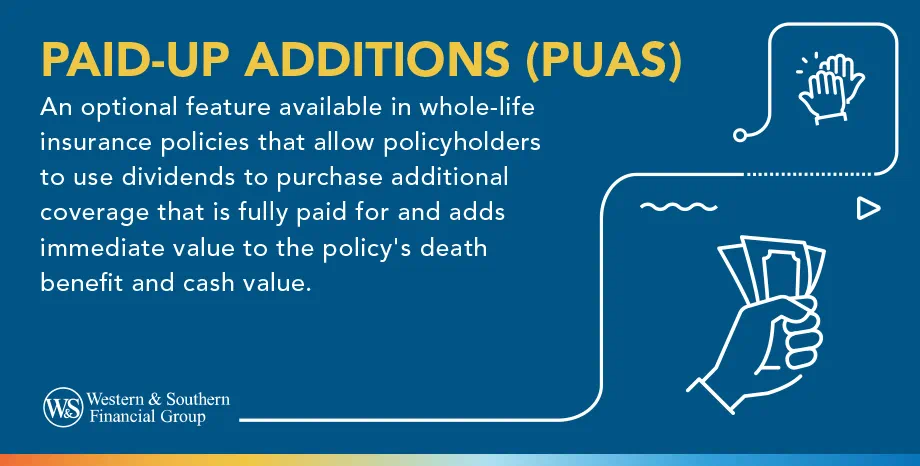

Key Takeaways
- Paid-up additions (PUAs) are small, fully paid life policies purchased with dividends or extra payments to boost a primary whole life policy.
- They immediately increase both the cash value (for living benefits and loans) and the death benefit without requiring new medical exams.
- The primary benefit is accelerated, tax-deferred growth that compounds over time, creating a larger and more flexible financial asset.
- The biggest risk is overfunding the policy and creating a Modified Endowment Contract (MEC), which eliminates the tax advantages on loans and withdrawals.
- The decision to use PUAs depends on long-term goals, risk tolerance, and balancing the need for liquidity against asset growth.
What Are Paid-Up Additions (PUAs)?
Think of paid-up additions (PUAs) as small, fully paid-for life insurance policies that you add to your primary whole life insurance policy. Each PUA is like a miniature version of the main policy, it has its own cash value and its own death benefit. When you purchase a PUA, that cash value and death benefit are added to your base policy's totals, immediately increasing its value.
These additions require no ongoing premium payments because the cost is covered at the time of purchase. You can acquire them over time, and each one you add contributes to a compounding growth cycle, making your entire life policy more robust. It's a method of dividend reinvestment that puts your policy's earnings to work immediately.
How Do Paid-Up Additions Work?
There are two primary ways to purchase PUAs, and both are typically associated with participating whole life policies issued by mutual insurance companies. These companies are owned by their policyholders and may distribute a portion of their profits back to them in the form of annual dividends.
- Using Life Insurance Dividends: This is the most common method. When the insurer pays a dividend, you have several dividend payment options. Instead of taking the dividend in cash or using it to reduce your premium, you can elect to use it to buy paid-up additional insurance. This method is a seamless way to boost your policy's value year after year automatically. Dividends are not guaranteed and may change at any time.
- Using a Paid-Up Additions Rider (PUAR): Many policies offer a Paid-Up Additions Rider. This rider allows you to make extra payments, above and beyond your regular premium, to purchase PUAs directly. This method is a potent strategy for individuals who want to accelerate their cash value growth significantly, outpacing growth achieved solely through dividends. The rider provides flexibility, allowing you to contribute varying amounts or even pause contributions if needed.
Once purchased, these additions begin earning their own dividends - if and when dividends are declared - which can then be reinvested in additional PUAs. This process may help create a compounding effect that could enhance your policy's long-term performance. However, it’s important to note that dividends are not guaranteed.
Boost Your Life Insurance Coverage with Paid-Up Additions Get a Life Insurance Quote
Example
Here’s a simplified example of how a policyholder might purchase paid-up additions (PUAs) in a whole life insurance policy:
- Policyholder Receives Dividends: John, a whole life insurance policyholder, receives annual dividends from his insurance company due to the company's strong financial performance.
- Option to Purchase PUAs: Instead of taking these life insurance policy dividends as cash or using them to reduce his premium payments, John opts to purchase additional paid-up insurance with his dividends.
- Immediate Effect of PUAs: Each paid-up addition increases John's policy's cash value and death benefit without requiring additional premium payments.
- Long-term Benefits: These paid-up additions grow over time, compounding the policy’s overall life insurance cash value. They offer John increased financial flexibility through higher policy loans and withdrawal options.
Pros: Benefits of Paid-Up Additions
Why would someone choose to put more money into their life insurance policy? The reasons go far beyond the death benefit alone. A policy optimized with PUAs becomes a multipurpose financial asset.
Accelerated Cash Value Growth
The primary driver for using PUAs is to turbocharge the growth of your policy's cash value. A significant portion of payments made through a Paid-Up Additions Rider is allocated directly to the cash value component. Keep in mind cash value may take years to accumulate unless a large premium is paid up front. This accelerated growth provides you with:
- Enhanced Living Benefits: A larger cash value creates a bigger pool of funds you can access during your lifetime.
- A Source of Private Capital: You can take policy loans against your cash value for any reason, often with favorable tax treatment. Loans or withdrawals should only be taken in emergency situations.
- Financial Flexibility: The cash value serves as a stable, liquid component of your overall investment portfolio, providing financial flexibility.
A Growing Death Benefit
Every PUA you purchase adds to your policy's total death benefit. This increase helps ensure the legacy you intend to leave your loved ones keeps pace with inflation and your goals.
Tax Advantages
The cash value within a life insurance policy grows on a tax-deferred basis. When you access this value via a properly structured policy loan, the funds are generally received income tax-free. This tax treatment makes a PUA-funded policy an attractive vehicle for building wealth shielded from annual taxation. The death benefit itself is also typically paid to beneficiaries free of federal income tax.
Cons: Drawbacks of Paid-Up Additions
While paid-up additions (PUAs) offer numerous benefits to policyholders, certain drawbacks and considerations should be evaluated when deciding whether to incorporate them into a whole life insurance policy. Here’s an overview of some potential disadvantages:
The Modified Endowment Contract (MEC) Risk
This potential risk is the most critical factor to monitor. The IRS sets limits on how much money you can pay into a life insurance policy within its first seven years (and upon specific policy changes). If you exceed these limits, your policy is reclassified as a Modified Endowment Contract (MEC).
What does this mean? A MEC designation permanently changes the tax rules for your policy.
- Taxable Distributions: Policy loans and withdrawals are no longer tax-free. Earnings are withdrawn first and are subject to income tax.
- Penalty Tax: If you take a distribution before age 59½, you could also face a 10% penalty tax on the earnings portion.
The death benefit remains tax-free, but the valuable tax advantages of the living benefits are lost. A knowledgeable financial advisor can help you structure your PUA payments to avoid triggering MEC status.
Dividends Are Not Guaranteed
PUAs are often funded by dividends from mutual life insurance companies. While many of these companies have a long and consistent history of paying dividends, they are not guaranteed to continue. In years where the company's performance is poor, dividends may be reduced or even eliminated, slowing the acquisition of new additions.
Should You Consider Paid-Up Additions?
Deciding whether to incorporate paid-up additions (PUAs) into your whole life insurance policy requires carefully considering your financial situation and goals, as well as an understanding of how PUAs work. Here are key factors to help determine if paid-up additions are a good fit for you:
- Financial Goals: If your primary aim is to enhance your life insurance coverage and increase the cash value of your policy, PUAs can be an effective strategy. They boost the death benefit and contribute to building a tax-advantaged cash reserve you can access during your lifetime. Consider your long-term financial objectives, such as providing for your family, estate planning, or funding your retirement.
- Long-Term Financial Future: PUA insurance may provide long-term benefits through the potential for increased cash value and death benefit over time. For individuals focused on long-term financial future, PUAs may be a useful tool to help meet those objectives.
- Long-Term Focus Through Life Insurance Policy Options: PUAs are typically associated with whole life insurance policies that offer guaranteed cash value growth and a level death benefit. For those with a more conservative financial approach, PUAs may offer a stable way to enhance the benefits of a whole life policy over time.
- Need for Liquidity: Consider how much access you need to cash. While Paid-Up Additions (PUAs) raise your policy's cash value and offer a loan option, using dividends to buy them might decrease your immediate cash availability compared to receiving dividends in cash. If you anticipate needing accessible funds soon, you might want to weigh the benefits of immediate liquidity against the long-term benefits of PUAs.
- Tax Planning: PUAs grow tax-deferred within a life insurance policy and can be valuable in tax planning. The cash value can be accessed via typically tax-free loans, and the death benefit is tax-free to beneficiaries. If tax efficiency is a significant aspect of your financial strategy, PUAs can be a compelling addition.
- Current Financial Health: Assess your current financial situation, including your ability to continue paying insurance premiums without financial strain. If you are in a stable financial position and can afford to reinvest dividends into PUAs without compromising your current lifestyle or financial obligations, they might be a strategic addition to your financial plan.
- Interest in Enhancing Insurance Benefits: If you're interested in maximizing the benefits your life insurance policy provides, PUAs are worth considering. Life insurance policy guarantees are subject to the timely payment of premiums. Loans and withdrawals will reduce the death benefit. They allow for the expansion of coverage and the increase in cash value without needing further medical exams or insurance company underwriting, making them a convenient option.
Whether or not to opt for paid-up additions depends on various factors specific to your financial needs and goals. They can offer significant benefits in the right circumstances, but require a commitment to a long-term perspective and understanding of their impact on your overall financial strategy.
Conclusion: A Strategic Tool for the Right Plan
Paid-up additions are a strategic choice for those looking to enhance their life insurance without further burdening their finances. They provide a flexible, growth-oriented way to help secure your and your loved ones' financial future.
Before making a decision, it's advisable to consult with a financial advisor who understands your overall financial situation and goals. They can help you understand how PUAs would fit into your broader financial strategy.
Boost Your Life Insurance Coverage with Paid-Up Additions Get a Life Insurance Quote
Frequently Asked Questions
Are paid-up additions taxable?
Paid-up additions (PUAs) in a life insurance policy grow tax-deferred, meaning that the cash value increase is not taxed while it remains within the policy. Withdrawals or loans taken against the cash value of PUAs are typically tax-free up to the premiums paid, but any gains withdrawn above the premium amount may be subject to income tax. If a life insurance policy is surrendered or lapses, the gains from PUAs could be taxable as income.
What is a Paid-Up Additions Rider (PUAR)?
A Paid-Up Additions Rider is an optional feature you can add to a whole life insurance policy that allows you to make additional premium payments to buy more "paid-up" insurance. This rider directly increases both your policy's cash value and death benefit, accelerating its growth far beyond what the base premium alone would accomplish.
Can I take a loan against my paid-up additions?
Yes. The cash value from your paid-up additions is combined with your base policy's cash value. You can take policy loans against this total accumulated value. A policy heavily funded with PUAs will have a much larger borrowing capacity than one without.
How do paid-up additions affect my death benefit?
Paid-up additions directly increase your total death benefit. Each PUA you purchase is a mini life insurance policy with its own death benefit, which is added on top of your original policy's face amount, creating a larger, income-tax-free payout for your beneficiaries.
What happens if I stop paying for my paid-up additions rider?
If your financial situation changes, you can typically stop making payments into the Paid-Up Additions Rider without penalty. Your base life insurance policy will remain in force as long as you continue to pay the required base premium. You will simply stop accelerating its growth with the extra PUA purchases.
What is the difference between Paid-Up Additions vs. Reduced Paid-Up Insurance?
- Paid-Up Additions: This is a strategy to actively add value to a policy you are still paying premiums for.
- Reduced Paid-Up Life Insurance: This is a "non-forfeiture" option you choose if you want to stop paying premiums entirely. You use your existing cash value to convert your current policy into a new one with a lower death benefit that is fully paid-up for life.
Disclosures
- Loans will accrue interest. Loans and withdrawals may generate an income tax liability, reduce the Account Value and the Death Benefit, and may cause the policy to lapse. Tax-free assumes the policy is not a Modified Endowment Contract (MEC), the withdrawals do not exceed cost basis, and the policy does not lapse.
- Interest is charged on loans, they may generate an income tax liability, reduce the Account Value and the Death Benefit, and may cause the policy to lapse.
- Withdrawals may be subject to charges, withdrawals of taxable amounts are subject to ordinary income tax, and, if taken before age 59½, may be subject to a 10% IRS penalty) and loans.
Sources
- 26 U.S. Code § 7702 - Life insurance contract defined – Legal Information Institute / Cornell Law School. https://www.law.cornell.edu/uscode/text/26/7702
- 26 U.S. Code § 7702A - Modified endowment contract defined – Legal Information Institute / Cornell Law School. https://www.law.cornell.edu/uscode/text/26/7702A















































